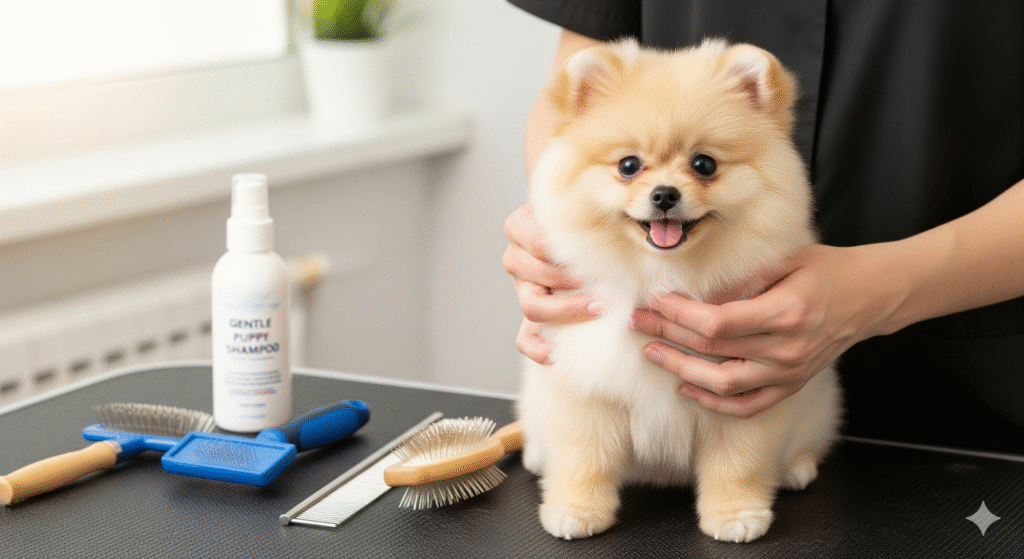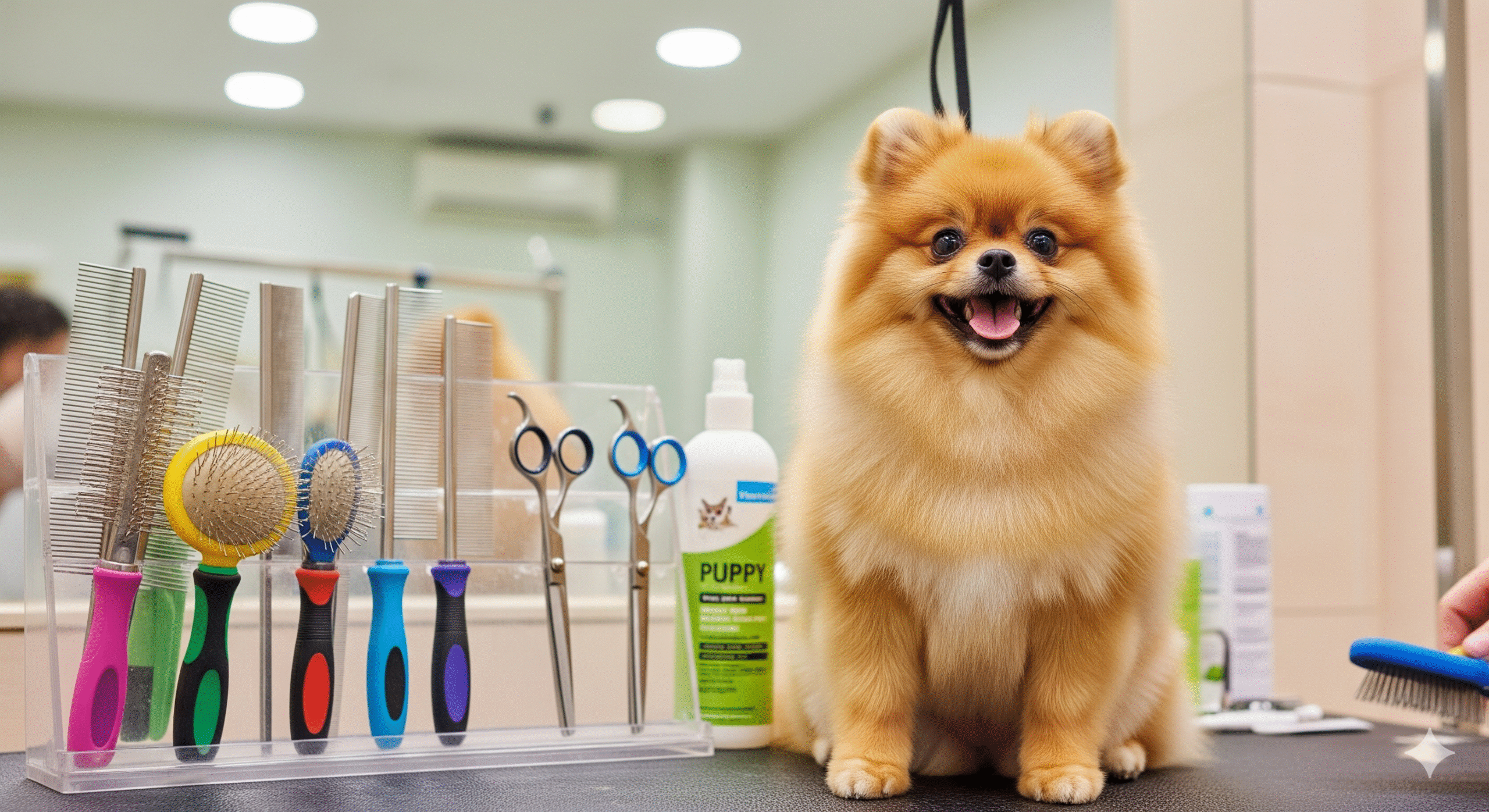With their fox-like faces, luxuriously fluffy coats, and personalities that far exceed their tiny stature, Pomeranians have captured hearts around the world. But behind that adorable, teddy-bear exterior lies a complex and spirited character. Raising a Pomeranian puppy isn’t just about cuddles; it’s about understanding a breed that is intelligent, bold, and requires dedicated, specific care—especially when it comes to their magnificent double coat. Without proper socialization and grooming, a Pom can quickly become a yappy, anxious, and matted mess.
This comprehensive guide delves deep into the unique world of the Pomeranian puppy. We’ll explore their larger-than-life personality and provide you with the essential grooming knowledge to keep your pup healthy, happy, and stunningly beautiful.
Here’s what we’ll cover:
✔️ The true Pomeranian temperament: beyond the “lap dog” stereotype
✔️ Socialization strategies for a confident, well-mannered adult dog
✔️ A complete, step-by-step grooming guide from brushing to bathing
✔️ Common health considerations linked to their size and breed
✔️ Training tips tailored to their intelligent but sometimes stubborn nature
✔️ How to prevent “Small Dog Syndrome” and raise a well-adjusted companion
Let’s unlock the secrets to a thriving life with your tiny, mighty Pomeranian.
Understanding the Pomeranian Personality: Big Dog in a Small Package 🧠
To live harmoniously with a Pom, you must first appreciate their unique character. They were bred down from larger sled-pulling Spitz dogs, and that working-dog intelligence and confidence remain.
Core Personality Traits
- Bold & Confident: Pomeranians are often unaware of their small size. They will confidently approach much larger dogs and people. This fearlessness needs to be carefully managed.
- Intelligent & Inquisitive: They are quick learners and highly observant. This makes them excellent trick dogs but also means they get bored easily.
- Extroverted & Loyal: They form incredibly strong bonds with their owners and thrive on being the center of attention. They can be velcro dogs, following you from room to room.
- Vocal: They are natural alert barkers. While this makes them good watchdogs, it can become excessive without proper training.
Potential Behavioral Challenges
- Small Dog Syndrome: This is not a medical condition but a set of behaviors (excessive barking, snapping, resource guarding) that arise when a small dog is not given clear boundaries, rules, and training because of their size.
- Separation Anxiety: Their strong attachment can lead to distress when left alone.
- Stubbornness: Their intelligence means they can be selective about when they choose to listen.
Socialization: The Key to a Well-Balanced Pom 🌍
Proper socialization is non-negotiable for a Pomeranian. The goal is to build their confidence and prevent the fear-based behaviors they are prone to.
- Positive Exposure: Introduce your Pom puppy to 100+ people (men, women, children, people in hats/uniforms), different surfaces, sounds, and gentle, vaccinated dogs.
- Avoid Overwhelm: Carry your puppy in busy places to avoid them being trampled or intimidated. Let them observe the world from the safety of your arms.
- Build Confidence: Use puzzle toys and short training sessions to build mental confidence. Agility, even at a tiny scale, is a fantastic outlet.
The Complete Pomeranian Puppy Grooming Guide ✂️
A Pomeranian’s coat is their glory, but it demands commitment. Start grooming the day you bring your puppy home.
1. Brushing: The Most Important Task 🖌️
Their double coat mats easily, especially behind the ears, in the armpits, and around the legs.
- Frequency: 2-3 times per week for maintenance. Daily during shedding season.
- Tools You’ll Need:
- Slicker Brush: For detangling the outer coat and removing loose undercoat.
- Steel Comb: The most important tool. Use it after the slicker brush to ensure you’ve reached all the way to the skin and removed every tangle.
- Pin Brush: For a final fluff and smooth of the long outer coat.
- Technique: Section the hair and brush all the way down to the skin. Never just brush the surface.
2. Bathing & Drying 🛁
- Frequency: Every 3-4 weeks, or when dirty.
- Process:
- Brush thoroughly before the bath. Bathing a matted coat will make the mats tighter and impossible to remove.
- Use a high-quality puppy shampoo and conditioner designed for long coats.
- Rinse extremely thoroughly. Any leftover product will irritate the skin and attract dirt.
- Blow-drying is mandatory. Air-drying will cause mats and can lead to hot spots. Use a force dryer on a low, cool setting to straighten and fluff the coat as you brush it.
3. The “Puppy Uglies” 🐻➡️🦊
Around 4-6 months old, your fluffy Pomeranian puppy will start to look a bit… strange. They lose their puppy coat, and the adult coat grows in. This process can be patchy and awkward. This is completely normal! Continue gentle brushing during this time to help remove the dead puppy fur.
4. Other Grooming Needs ✨
- Eyes: Clean around them daily with a soft, damp cloth to prevent tear stains.
- Ears: Check and clean weekly with a vet-approved ear cleaner.
- Nails: Trim every 2-3 weeks. Long nails affect their gait and can cause pain.
- Teeth: Crucial. Pomeranians are prone to dental disease. Brush their teeth daily.
Pomeranian Health Considerations 🩺
Their tiny size comes with specific health predispositions.
- Dental Disease: The #1 issue. Crowded teeth lead to rapid tartar buildup. Daily brushing and annual vet dental checks are essential.
- Luxating Patella: A dislocating kneecap. You may see them “skip” on a back leg for a few steps.
- Collapsed Trachea: A weakening of the windpipe rings. Always use a harness, never a collar, to avoid pressure on the throat.
- Hypoglycemia: Low blood sugar can affect very small puppies. Ensure they eat regularly and know the signs (lethargy, weakness, trembling).
⚠️ Warning on “Teacup” Poms: There is no official “teacup” breed. This is a marketing term for runts or intentionally underbred dogs, which are far more prone to severe health problems. Choose a reputable breeder who prioritizes health.
Training Your Pom: Intelligence Meets Independence 🎓
- Use Positive Reinforcement: They respond brilliantly to treats, praise, and play. Harsh methods will break their spirit.
- Keep Sessions Short & Fun: Their attention span is short. Aim for 5-minute sessions multiple times a day.
- Prioritize These Commands:
- “Quiet” to manage barking.
- Recall (“Come”) for safety off-leash.
- “Drop it” to prevent them from picking up dangerous items.
Final Checklist for a Happy, Healthy Pomeranian ✅
☑️ I have a slicker brush and a steel comb for daily grooming.
☑️ I have a harness for walks to protect their trachea.
☑️ I have a doggy toothbrush and toothpaste and am committed to daily brushing.
☑️ I have a plan for extensive socialization with positive experiences.
☑️ I understand the importance of not spoiling them due to their size.

Trying to Decide on a Puppy Class? You’ve learned the basics of socialization, but now you need to decide if a formal class is the right next step for you and your pup. It’s a big decision that depends on your budget, your puppy’s temperament, and the quality of classes in your area. For a comprehensive guide to help you decide, read: Puppy Socialization Classes: Are They Worth It?.






